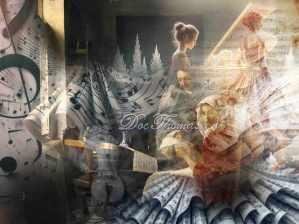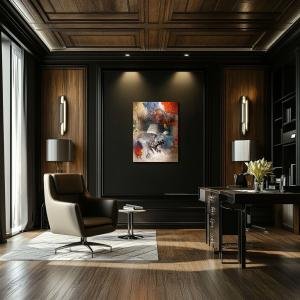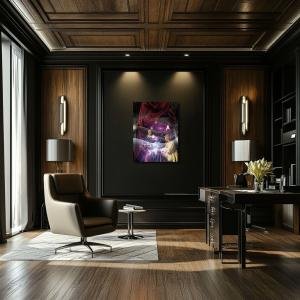Veins of Porcelain: Sonata in a Shattered Room
Veins of Porcelain: Sonata in a Shattered Room reinterprets Vermeer’s Girl Interrupted at Her Music as a swirling symphony of memory and spectral performance. Notes escape their paper prisons to become architecture and attire. The girl’s poised stillness dissolves into layered echoes of self, with musical sheets blooming into skirts and figures. A piano arches like a cathedral, while ghostly rhythms of violet, ivory, and crimson swirl around her. No longer a moment paused, this is a sonata suspended in longing—a room where music never ends, but the melody is always out of reach.
Please see Below for Details…
Hotline Order:
Mon - Fri: 07AM - 06PM
404-872-4663
Veins of Porcelain: Sonata in a Shattered Room reimagines Johannes Vermeer’s Girl Interrupted at Her Music as a baroque hallucination—an orchestral unraveling of memory, gender, and interrupted longing. Where Vermeer once offered calm and harmony in the precision of light and gesture, this version tears open the silence to reveal a turbulent sonata of desire, nostalgia, and ghosted performance. The girl and her music are no longer merely paused—they are trapped in an infinite refrain, surrounded by spectral figures spun from notation and echoes. Her gaze—once coy, perhaps flirtatious—is now introspective, suspended in an interlude that never resolves.
The transformation begins with space itself. The original geometry of the room—anchored by windows, shadows, and polished furniture—has been dissolved into lyrical abstraction. Sheets of music erupt and spiral like fabric caught in wind, wrapping around bodies, bending light, and collapsing chronology. Vermeer’s figures are multiplied, overlapped, their identities split between performer and reflection, memory and presence. A woman becomes a piano lid. A skirt becomes a symphony. And the girl is no longer interrupted—she is the interruption itself.
The color language of this composition carries emotional turbulence across tonal registers. Soft ivory whites and greys drift like slow arpeggios across the canvas, suggestive of quiet resignation and the hush between movements. Warm honey golds and subdued ochres carry Vermeer’s original palette forward, but they bleed into lavender shadows and silvery violets, revealing the melancholy of memory dressed as elegance. Crimson notes subtly lace the folds of the music sheets, hinting at passion withheld, a fire tucked beneath discipline. The music notes—no longer ink on paper—now shimmer with a cool, unnatural blue, glowing faintly like stars arranged in forgotten harmonies.
Behind the figures, a piano tilts like an altar, open not just to sound but to confession. Its keys disappear into light, and its form stretches into metaphysical suggestion—a passageway, a mirage, a measure of time undone. Notes curl outward into the air, forming trees, curtains, even dresses. These transformations are not decorative but symbolic. Each measure of music, once linear, is now cyclical. A loop. A haunting. A memory trying to remember itself.
As the artist, I envisioned this work not just as a reinterpretation of Vermeer’s stillness, but as a requiem for unspoken dreams. The girl’s interruption is no longer a simple pause—it is a metaphor for lives deferred, for artistry interrupted by expectation, for female creativity held just at the edge of full voice. What if, instead of silence, the pause had become explosion? This painting attempts to answer that—by letting the notes take over, by allowing the music to become everything.
There is a duet playing, even if we cannot hear it. It is performed by shadows—by the woman with her fingers still hovering over unseen keys, by the girl emerging from the ruffled skirt of notation, by the gaze of the male figure who becomes background rather than subject. And through them, the music continues, but without closure. Every measure breaks apart before resolution. It is a fugue of unfinished thoughts.
The symbolism here turns Vermeer’s chamber scene into a mythic interior. The girl becomes the music itself: an embodiment of the tension between composition and chaos. She is poised within layers of performance and reflection—elevated, consumed, and dispersed by the very structure she tries to inhabit. The interruption becomes eternal, but not passive. It becomes the echo that writes itself back into the composition.
Veins of Porcelain: Sonata in a Shattered Room is a painting about music, but also about constraint. It is about how beauty is rehearsed, staged, interrupted. How performance becomes identity, and how sometimes the deepest truth lies in what is never played. It reinterprets Vermeer not by distorting him, but by letting the silence around his women finally speak in full chorus.
Add your review
Your email address will not be published. Required fields are marked *
Please login to write review!
Looks like there are no reviews yet.










